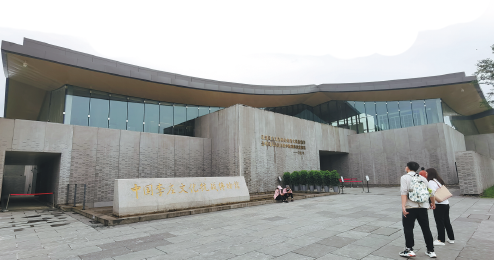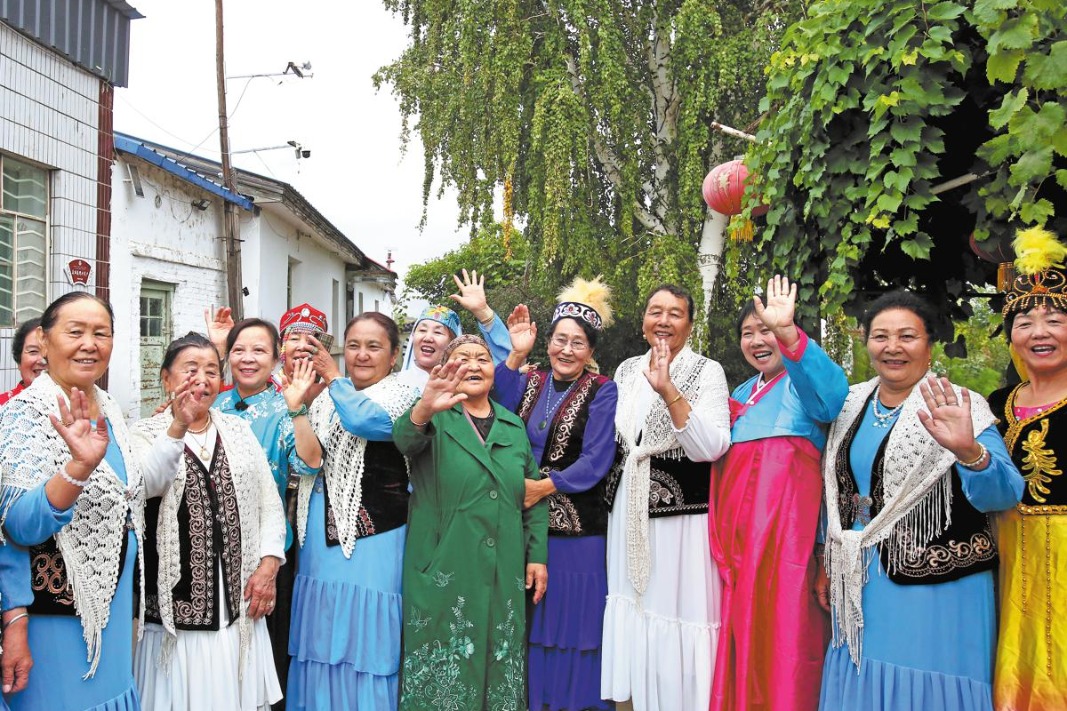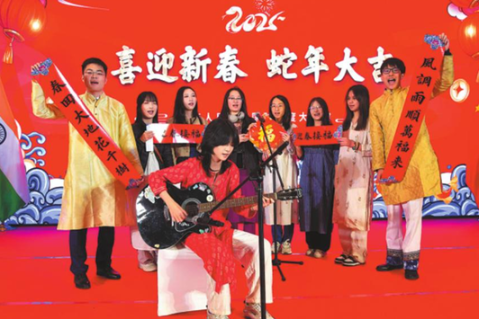Academic refuge
The old town of Lizhuang still draws tourists with its wartime contribution, Huang Zhiling and Quan Yubin report.

Despite the latest sporadic COVID-19 outbreak in Southwest China's Sichuan province, people are flocking to Lizhuang, a 1,478-year-old town on the southern bank of the Yangtze River, on weekends and holidays.
During the five-day Labor Day holiday from April 30 to May 4, a daily average of 30,000 people arrived in the small town in Yibin, Sichuan, said Pan Chengjun, head of the tourist service center of the town's management committee.
Many tourists have taken their children on historical tours of the town, as it has become one of China's four wartime cultural centers along with Chongqing, Chengdu in Sichuan, and Kunming in Yunnan province.
After the Lugou Bridge Incident (July 7, 1937), in Beijing, the Japanese troops started an all-around invasion of China, leading to the War of Resistance Against Japanese Aggression (1931-45).
To take refuge during the war, people from important Chinese institutions such as the Central Research Institute and preparation department of the Central Museum in Nanjing, Jiangsu province, which was the seat of the Kuomintang government, and other institutions of higher learning like the National Tongji University in Shanghai, stayed in Lizhuang from 1940 to 1946.
Three thousand boxes of porcelain and pottery wares made during the reign of Emperors Kangxi and Qianlong in the Qing Dynasty (1644-1911) were transported to Lizhuang from the Central Museum and kept in the town for six years.
After their campus in Shanghai was destroyed by Japanese warplanes, the teachers and students of the National Tongji University passed nine Chinese provinces and Vietnam, traveling more than 11,000 kilometers before settling down in Lizhuang, which was not on the Japanese military map, in 1940, thanks to the help of Qian Zining, a graduate of the university who was the boss of a papermaking factory in Yibin.
On the wall of a showroom at the university's medical college in Lizhuang is a photo of three female students. The caption reads that they later became pillars of their motherland. The visitors may think of the wartime odyssey and how loved ones worried about them.
Lizhuang, which covered an area of 1 square km, had 3,000 inhabitants at the time. To accommodate 12,000 students and scholars, locals volunteered to provide them with their own homes and temples as teaching buildings and residences free of charge, said Fan Wangna, a town guide.
As the Japanese army never entered Sichuan, the National Tongji University never stopped enrolling students in Lizhuang, and the institutions that relocated staff there continued to work.
Adhering to the belief of saving the country with science and serving the country with academics at a time marked by the shortage of materials, and the struggle against poverty, the scholars never stopped learning or research.
Visitors to the Palace Museum in Beijing may find a stone carving of more than 1,800 years ago that portrays a naked man and a woman hugging and kissing. The carving, 49 centimeters tall and 43 cm wide, and commonly referred to as "the first kiss under heaven", appears unusual because it was made during the Han Dynasty (206 BC-AD 220) when personal intimacy was kept private.
The carving, one of China's earliest portrayals of sex in art, was excavated in Jiangkou town in Pengshan county, Sichuan, in 1942, after the Institute of History and Philology, Academia Sinica, the preparation department of the Central Museum, and the Society for the Study of Chinese Architecture in Peking moved their staff and campuses to Lizhuang. An archaeological team consisting of staff members of the three institutions worked on cliff tombs in Jiangkou and excavated many cultural relics, including the stone carving.
In the spring of 1943, the team participated in the excavation of the Yongling Mausoleum in Chengdu, Sichuan, studied its cultural relics and contributed to the research in art of the Five Dynasties and Ten Kingdoms (907-960) period.
The Yongling Mausoleum, where Wang Jian (847-918), founder of the Shu Kingdom (907-925) was buried, is the only ancient mausoleum found in China to have been built above ground.
Inside the mausoleum are relief sculptures of two female dancers alongside 22 female musicians that were members of Wang's imperial band, as well as a stone statue of a seated Wang. They are China's most completely preserved sculptures of an imperial band of the Tang Dynasty (618-907) while the effigy of Wang is believed to be China's only statue carved on the basis of an emperor's true appearance.
Surrounded by vegetable fields, a house inhabited by Liang Sicheng and his wife, Lin Huiyin, two masters in architecture, is in Lizhuang. In the study is the effigy of Liang working with his assistant Mo Zongjiang, who later became one of the leading designers of the national emblem of the People's Republic of China after it was founded in 1949. During their six-year stay in Lizhuang, Liang and Lin visited most ancient structures in Sichuan. It was there that Liang compiled the book History of Chinese Architecture, the first book of its kind in China.
To support a family of five, the poor couple had to plant vegetables in their courtyard. When John King Fairbank, a lifetime professor of Harvard University, visited Liang and Lin, in Lizhuang, in 1942, he lived in their home. He said that Americans would have deserted books if they were in the same financial state.
Scholars living in Lizhuang were poor back then. Fu Sinian, head of the Institute of History and Philology, Academia Sinica, once sold books to make ends meet.
But occasionally a few would dine in restaurants to taste the famous "white meat", a local delicacy that is made of pig's hip. Each piece of the "white meat" is about 15 cm long and 1 millimeter in thickness.
Every resident of Lizhuang knows the story of Dr W. Wait, a Polish professor in the college of technology at the National Tongji University.
"As locals could not communicate with him in a foreign language, Wait would pat his hip if he wanted to eat the white meat," Fan said.
Unfortunately, Wait who had taught at the National Tongji University in 1939 died of peritonitis and was buried in Lizhuang in 1945, when medicine was in great shortage in the town.
Forty-three people who worked or studied in Lizhuang in the 1940s later became academicians of the Chinese Academy of Sciences and the Chinese Academy of Engineering.
One of them is Wu Mengchao (1922-2021), known as "the father of hepatobiliary surgery" in China, who had saved or extended the lives of more than 14,000 patients with his scalpel before he died aged 99 in 2021.
In 2011, the International Astronomical Union named a minor planet No 17606, discovered by the Beijing Schmidt CCD Asteroid Program, after Wu in recognition of his achievements. Wu had revisited Lizhuang many times. In 2016, he operated on a patient at the Tongji Lizhuang Hospital to mark its opening and he served as its lifelong honorary president. A photo of Wu sitting in a bamboo chair on Mat Street in Lizhuang is kept in a showroom in the National Tongji University's medical college in the town.
Streets in the town retain old names, such as Mat, Sheep and Well streets. They are paved with slab stones and many houses are made of wood and orderly arrayed.
In the Yuwang Temple, which was the headquarters of the National Tongji University during the war, one 200-year-old or so stone carving of nine dragons bears a strong resemblance to that of the Palace Museum in Beijing. On the 24 window bars of the main hall of Zhang's Ancestral Temple, where 3,000 boxes of porcelain and pottery from the Central Museum were kept for six years, there are 48 carved cranes around which are hollowed-out "clouds". The crane figurines have 48 different postures, either spreading wings or flying or looking for food.
Cai Lizhi contributed to the story.



Today's Top News
- Xi visits exhibition marking 70th founding anniv. of Xinjiang Uygur autonomous region
- Shenzhou XX crew to conduct fourth spacewalk in coming days
- US, EU leaders air divisions
- Visit by US lawmakers expands dialogue
- Prosecutors eye tech edge to combat financial crimes
- Xi: Pool efforts to build 'beautiful Xinjiang'






























